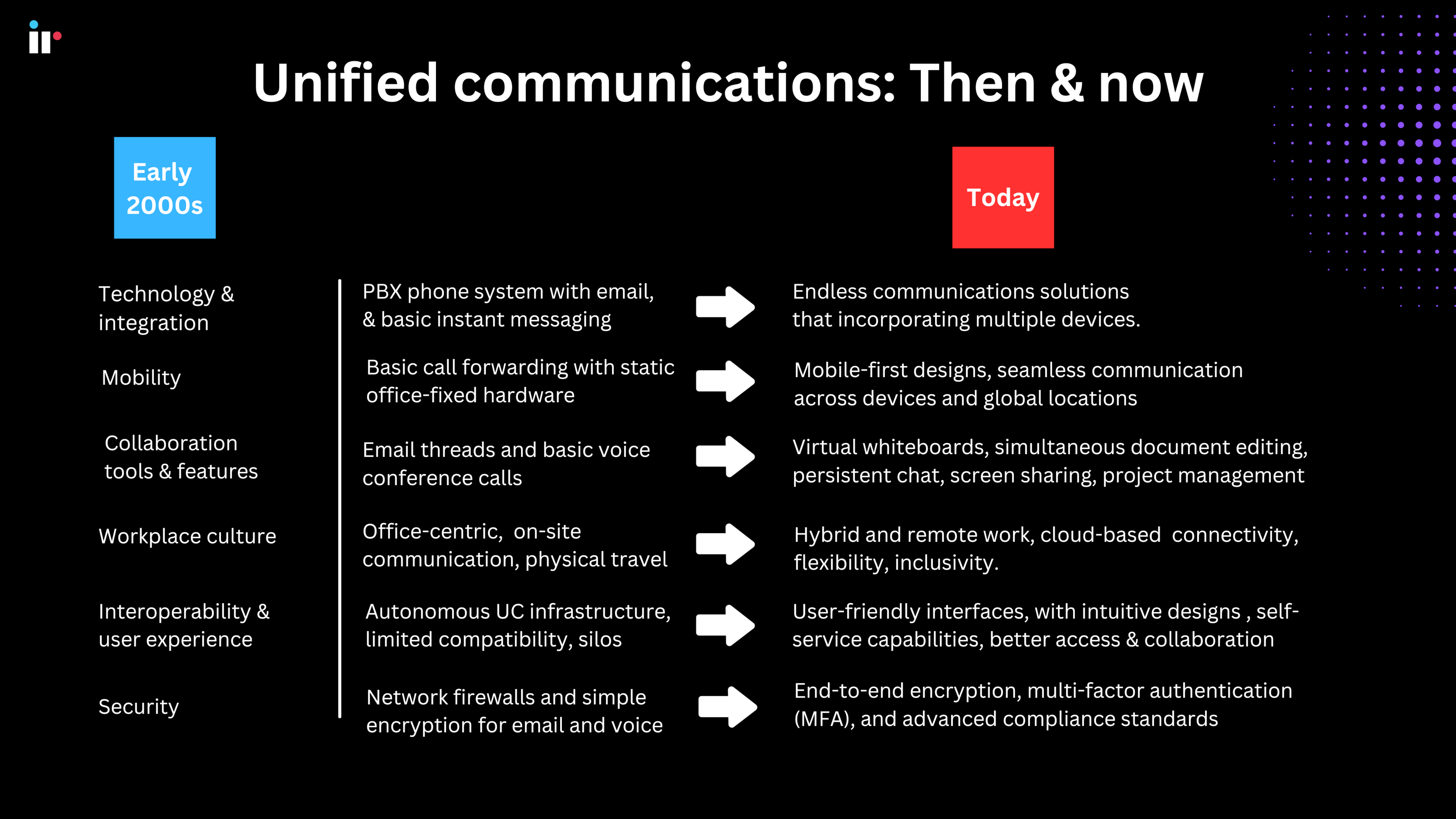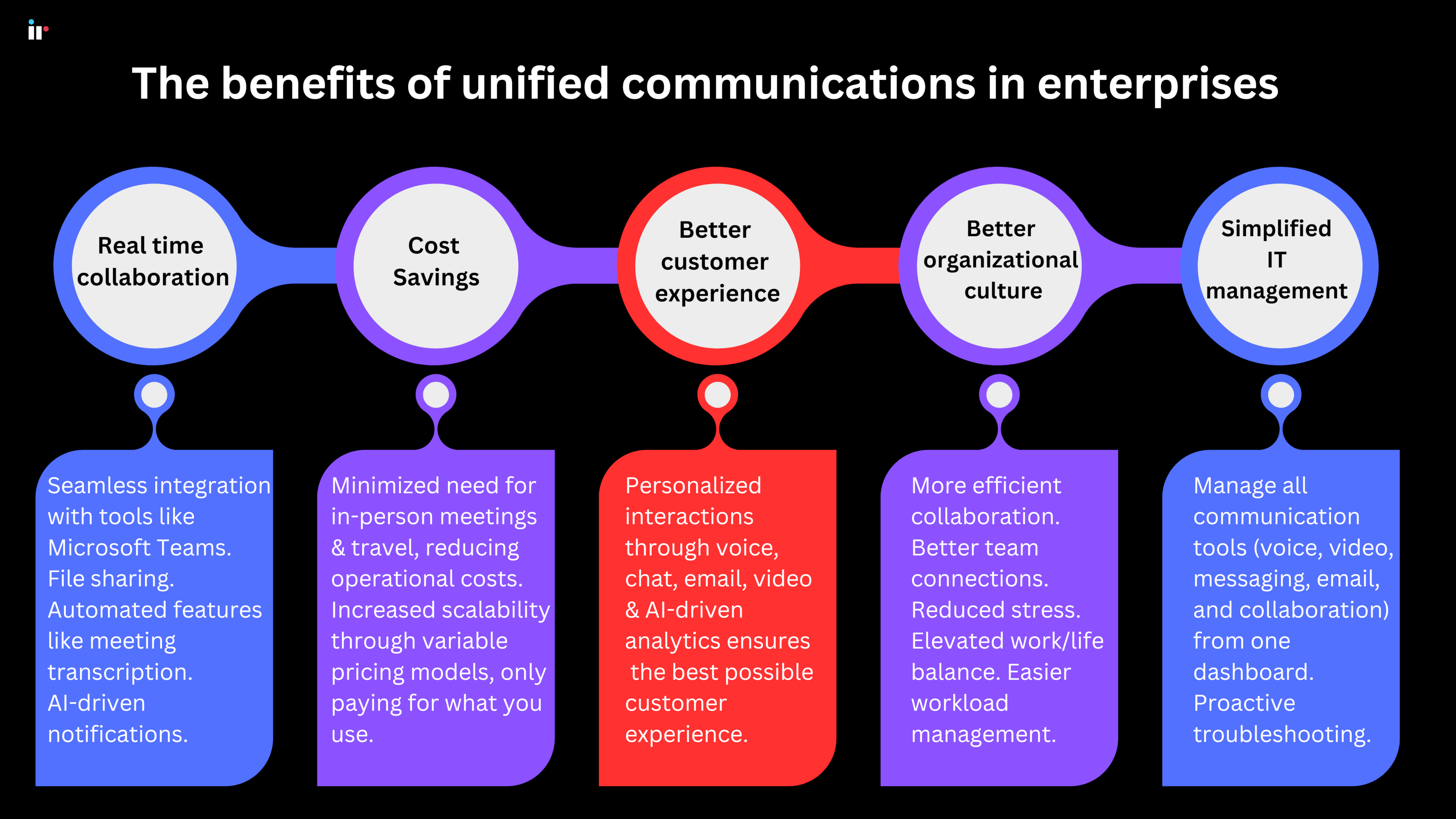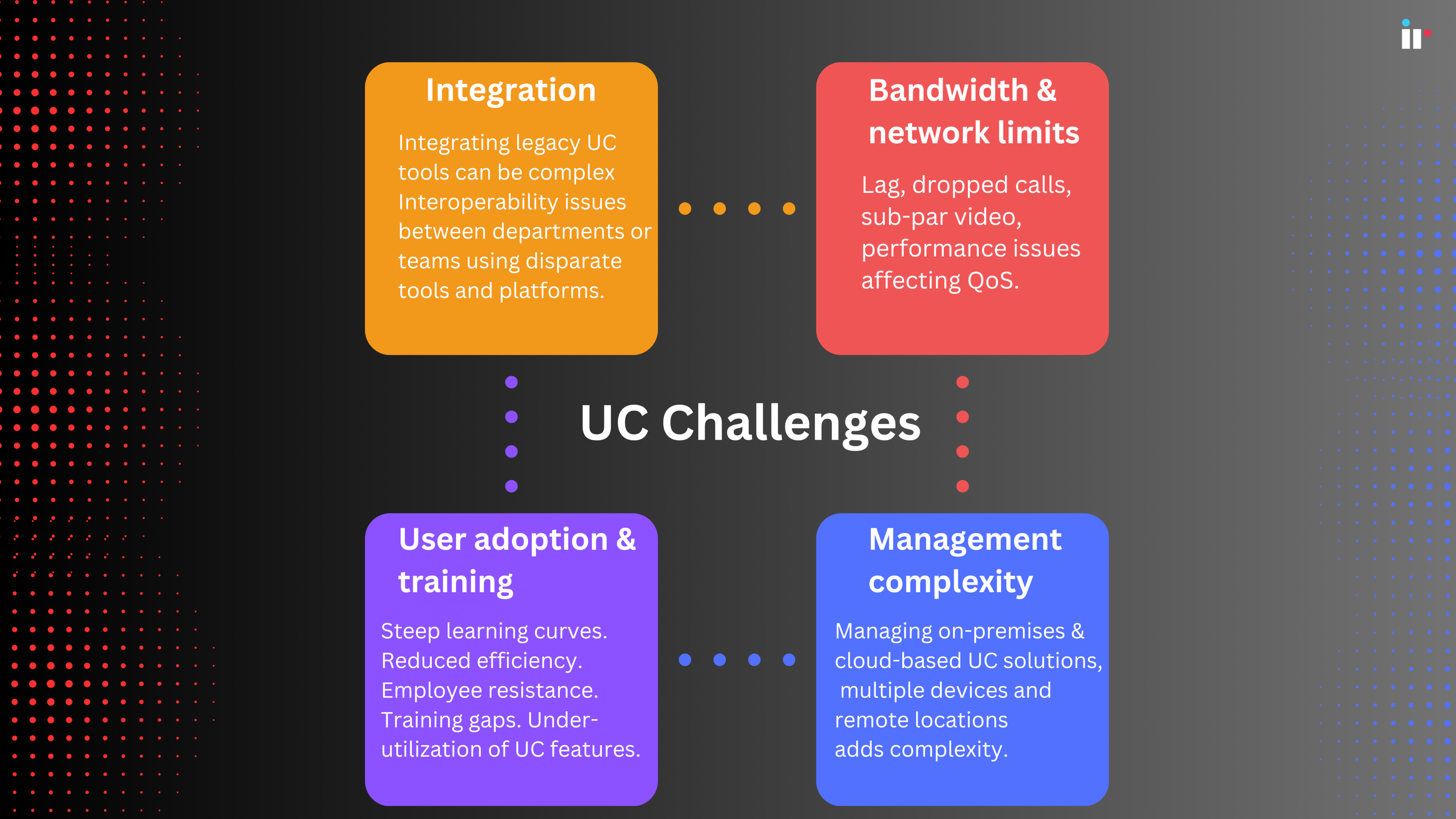Unified communications (UC) is a collective term that all enterprise organizations are familiar with, as it forms the cornerstone of business operations.
Consolidating business communications systems, devices and applications into a consistent unified user interface, enables streamlined team collaboration between remote employees, and all stakeholders in an enterprise organization.
The goal of unified communications solutions is to improve user experience and business efficiency, while increasing productivity through better collaboration and integration.
A well-planned unified communications strategy is crucial for achieving long-term growth. In this guide, we'll aim to provide a thorough understanding of UC platforms, UC collaboration tools and business applications, and some of the UC challenges many enterprises face - and strategies to overcome them.
Unified communications then and now
Enterprise unified communications has transformed significantly over the past 25 years, driven by rapid advancements in new technology, ground-breaking shifts in work culture, and along with it, the rise of new communication needs.

Technology and integration
At the start of the 2000s, enterprise unified communications was primarily focused on integrating a voice-only legacy PBX phone system with email, and basic instant messaging.
Video conferencing was in its infancy in the early 2000s, with mostly free internet services such as Skype and iChat, web plugins supporting H.26x video standards, and online telecommunication programs that promoted low cost, but usually low quality video communication.
Systems were largely on-premises, requiring significant hardware investments and maintenance.
Today's UC landscape comprises an almost endless array of communications solutions that can incorporate multiple devices.
External communications now operate via video conferencing and team collaboration platforms like Zoom, Microsoft Teams and Slack.
Mobile applications and AI-driven communication is prolific within the UC market. Most enterprise unified communications platforms are cloud-based, offering scalability, easier updates, and integration with other business tools like CRM and project management software.
Mobility
Two decades ago, communication and collaboration usually involved fixed desk phones or static, office-fixed hardware. Mobile integration was limited and basic call forwarding or SMS was basically all that enterprises had to work with.
Today, UC functionality is centered around mobile-first designs, that enable seamless communication across devices and global locations. Employees, clients and customers can access UC platforms on smartphones, tablets, and laptops, enabling remote and hybrid work environments and seamless business communications.
Collaboration tools and features
Before the phrase Unified Communications was even coined, collaboration was primarily carried out through email threads and basic voice conference calls. File sharing and co-editing options were minimal or nonexistent within communication and collaboration platforms.
Real time collaboration is now a key component of modern unified communications platforms, particularly multiple-user video calling and virtual meetings. Features like shared virtual whiteboards, simultaneous document editing, persistent chat, screen sharing and project management capabilities have allowed faster, more efficient means of communication for enterprise organizations.
Workplace culture
Work culture was predominantly office-centric, with UC tools catering to on-site communication needs in bricks-and-mortar locations. Teams would need to be physically present, and for organizations with globally dispersed locations, travel for conferences and meetings was a major operational expense.
Hybrid and remote work is standard in unified communications today. Advanced technologies and evolving cloud based UC systems are cost efficient, and ensure that remote workers stay connected, productive, and aligned, supporting flexibility and inclusivity throughout all UC projects.
Interoperability & user experience
Before enterprises began to focus on interoperability, almost every UC platform within an organization's unified communications infrastructure functioned autonomously. Limited compatibility across vendors often resulted in siloed systems, so data was often difficult to access. Interfaces were basic, requiring training, and user experience was inferior.
Today's open APIs and revised industry standards are interoperable between unified communications platforms, fostering a more connected ecosystem. User-friendly interfaces, with intuitive designs and self-service capabilities provide better access across each UC system, allowing better collaboration between teams.
Security
With less sophisticated technology making up an organization's unified communications platform, the focus on security was not as concentrated and was often limited to network firewalls and simple encryption for email and voice.
The complexity of today's UC environment requires far more security to protect data. End-to-end encryption, multi-factor authentication (MFA), and advanced compliance standards like GDPR, HIPAA now exist to safeguard communications.
The benefits of unified communications in enterprises
The beneficial impact of today's UC solutions is wide-ranging. From enhancing productivity, and enabling better collaboration - to creating a superior experience for customers and better data accessibility for contact center agents.
UC tools can simplify management processes and allow employees, stakeholders and customers to communicate seamlessly. This gets things done faster and more efficiently, giving businesses a more competitive edge that can lead to increased revenue and business growth.
Some of the key benefits include:
Real time collaboration across teams & stakeholders
The ability to communicate across all UC systems in real time is a game-changer for enterprise organizations. Slower, more reactive solutions like email and voice mail have been replaced by instant messaging notifications, video conferencing, and shared virtual workspaces that foster proactive collaboration across distributed teams.
Seamless integration with tools like Microsoft 365, Microsoft Teams, Slack, or Google Workspace allows teams to co-edit documents, share files across all media types, and brainstorm ideas no matter where they are, or what UC products they're using, in real time.
Working in real time also increases productivity and streamlines workflows by consolidating communication tools into one platform. Automated features like meeting transcription, call routing and AI-driven notifications help to reduce manual tasks and enable teams to work far more efficiently whether in the office, or from a remote location.
Cost Savings
Cloud-based UC systems lead to lower operational costs by eliminating the need for expensive on-premises hardware, which comes with the need for constant maintenance and updating or replacement.
High-quality video conferencing and virtual collaboration tools minimize the need for in-person meetings and travel, enabling better cash flow through reduced operational costs.
Subscription-based UC solutions enable scalability through variable pricing models, allowing organizations to pay only for what they use. This makes it easier to scale up or down based on market fluctuations or development opportunities.
Better customer experience
Unified communications has brought about a significant shift in the way businesses engage with customers. There's a direct link between customer experience and revenue growth, and understanding this link is vital for enterprise businesses.
With numerous available communication channels across voice, chat, email, and video, businesses can ensure that their interactions with customers is timely and personalized, leading to increased customer retention and loyalty.
Integration with CRM systems allows contact center agents to access customer histories through a single platform enabling tailored service during calls or chats.
AI-driven analytics provide detailed insights from communication patterns helping contact center agents to identify customer needs and optimize customer service delivery.
For more information on the importance of customer experience
Read our guide
A better organizational culture
UC tools help to foster efficient collaboration and build team connections, and this is important in large enterprise organizations where there are often silos and less than adequate cross-departmental communication. Free flowing communication fosters a culture of transparency and trust
Improving employee engagement has been shown to boost productivity, reduce workplace stress and motivate employees to align their efforts with organizational objectives. This ensures that everything they do in the workplace contributes directly to the company’s success
Feedback channels within a unified communications infrastructure provides platforms for employees to voice their ideas or concerns through chat, surveys, or team discussions.
Today's advanced unified communications tools allow flexibility, leading to a better work-life balance through the use of mobile and cloud-based UC solutions that let employees work from anywhere. Tools like asynchronous messaging and recorded meetings allow employees and teams to manage their workloads efficiently.
Read more about the true cost of poor employee experience
Simplified IT management
Today's unified communications solutions have changed the way IT teams manage communications ecosystems. They can now manage all communication tools (voice, video, messaging, email, and collaboration) from one dashboard.
It's easier than ever to add, remove or update users, reducing administrative tasks, and as many UC solutions are cloud-hosted, this eliminates the need for complex hardware installations, accelerating deployment timelines.
They can consistently apply security settings, compliance rules, and usage policies from a central location.
From a unified dashboard, IT teams can proactively troubleshoot devices and applications, update systems, and monitor performance.

UC challenges
While unified communications provides significant benefits for enterprise organizations, successful implementation and operation can face several challenges, including technological, operational, and cultural factors.
Integration challenges
Integrating legacy UC tools with existing systems like PBX, CRM, or ERP can be complex and costly, often calling for replacing entire systems.
Interoperability issues between different departments or teams using disparate tools and platforms can hinder integration, as can tailoring UC solutions to align with unique business processes.
Bandwidth and network limitations
High-quality UC services require robust network infrastructure. Poor bandwidth can cause performance issues like lag, dropped calls, or low-quality video. This in turn can affect QoS and prioritizing UC traffic over other network usage to maintain performance can be challenging.
User adoption and training
Often, the introduction of new communications platforms can cause resistance from employees, and training gaps leading to underutilization of UC features.
Some unified communications platforms have steep learning curves, reducing efficiency during the transition and causing user frustration and employee churn.
Management complexity
Managing a mix of on-premises and cloud-based UC solutions, as well as multiple devices and remote locations can increase administrative complexity.
Monitoring and analytics requires sophisticated tools and expertise to ensure that issues with collaboration systems are resolved effectively and proactively.

Strategies for UC success through monitoring and management tools
Achieving success with enterprise unified communications requires effective monitoring and management to ensure optimal performance, seamless user experiences, and proactive issue resolution.
Implement proactive monitoring
Enterprise level monitoring tools like IR Collaborate provide real time insights through live, customized dashboards that can track call quality, bandwidth usage and overall system performance. Proactive monitoring also provides alert systems for potential issues like dropped calls, high latency or system outages so that IT teams can respond before issues escalate and lead to downtime.
Leverage analytics and reporting
By analyzing usage data you can identify which tools and applications are used most, and those that are underutilized, helping to refine training and adoption strategies.
Monitoring metrics like jitter, latency, and packet loss identifies and resolves connectivity issues, while leveraging analytics can ensure that communications align with compliance and regulatory requirements.
Monitor end-user experience
Insights into end user experience are important to keep track of any issues that may be impacting productivity and/or functionality. Monitoring tools can also generate scores for user satisfaction and performance, flagging areas for improvement.
Ensure robust security monitoring
The best monitoring tools can detect unusual activities or potential breaches in UC systems in real time, and can continuously monitor encryption protocols to ensure secure communications.





